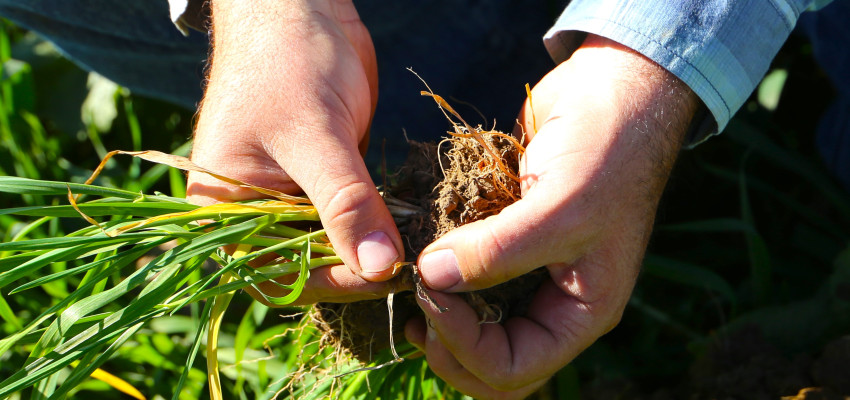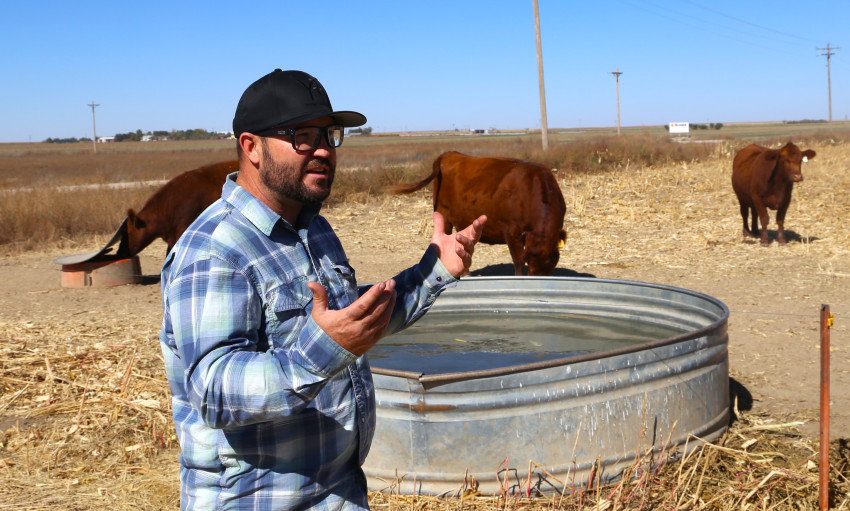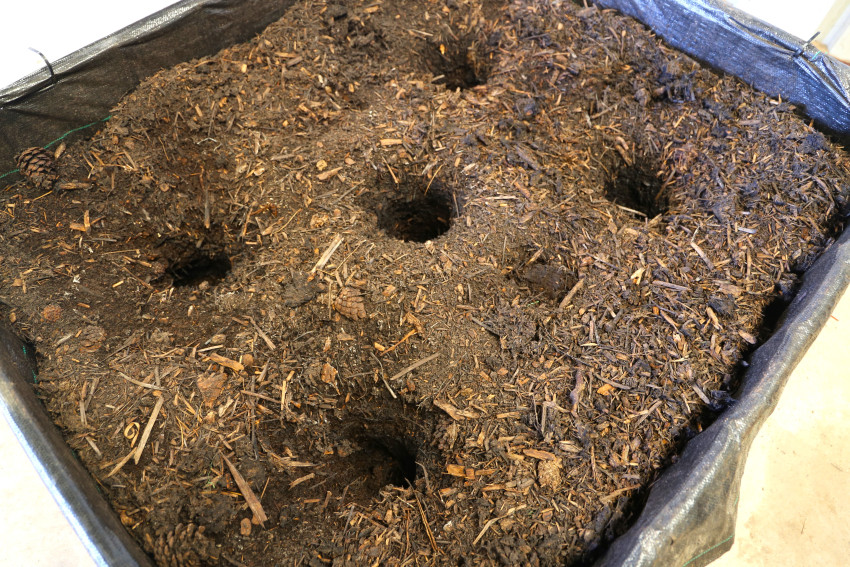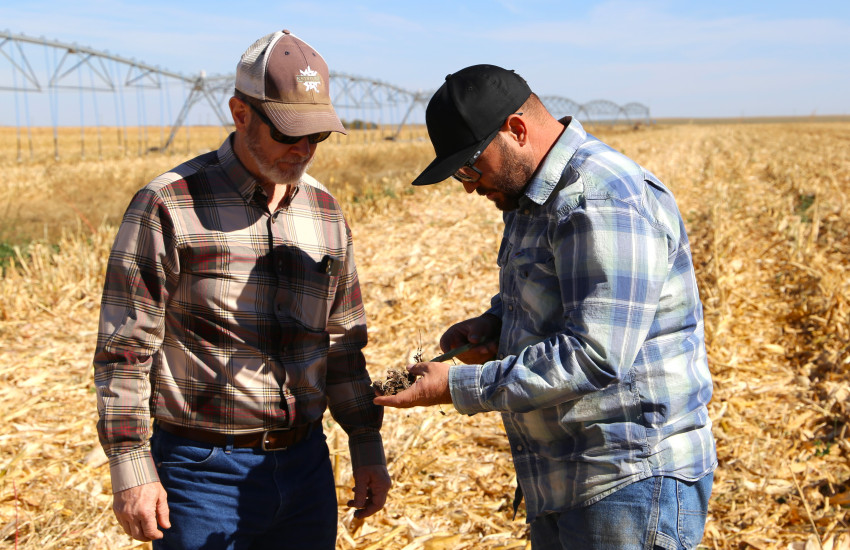Jay Young thought he was going to a friend’s house to play cards in 2016, but the Greeley County farmer hadn’t even picked up a deck before he got pulled into a discussion about cover crops. While he never got dealt a hand, Young didn’t go home without a winning idea.
“I went from being super annoyed I was missing out on playing cards with my friends to this is fascinating,” Young says. “I studied all of a month and brought my deep analysis that you can get in one month of studying to my dad and told him I was going to run a cow-calf operation on cover crops.”
Young says his father was wary of the idea to plant a crop specifically for cattle, but he didn’t stand in the way of his son attempting to realize a childhood dream of adding cattle to their farming operation. Cover crops, a mix of plants like ryegrass, clover and radishes, are traditionally planted to protect and enrich soil. Those benefits didn’t interest Young initially, rather he views the cover crops as a way to provide forage on land normally devoted to crops.
“For the first few years I was only interested in cover crops because it was a way to raise cattle,” Young says. Everything I learned about cover crops was great, but it was just a means to feed cattle. I’d learn these things about soil, but it was all for the cattle.”
CATTLE 101
It wasn’t that Young hadn’t been around cattle before, his family had run “stocker” cattle, meaning they grazed weaned calves until they were big enough for a finishing yard, which doesn’t come with the year-round commitment of a cow-calf operation.
“As a stocker guy I never looked at teat size or foot quality,” Young says. “I just wanted to know if the cattle would put on weight.”
Developing a herd of his own meant more studying for Young, and even more questions for other ranchers. He chose Red Angus because he saw the heifers top the market at a sale one time, but beyond that he admits he knew even less about raising cattle than he did cover crops when he got started.
“I’d call people and ask them what their program is, what their vision is,” he says. “They’d say they’re looking for good feet, good udders. I’d ask, “What does good feet and good udders mean to you?’”
PRINCIPLES OF SOIL
It wasn’t until 2019 that Young began to better understand how a few principles could change how he viewed his role in improving soil health, which he admits was intimidating in the beginning. Those include the following keys:
- Know your context
- Living root in the ground
- Armor on the soil
- Diversity of species
Young says the principles are all dependent on knowing the context of your soil and climate. Where he farms on the High Plains of western Kansas, keeping a living root in the ground is something he strives for “as long as possible” where others can do so year round based on their climate. Armor on the soil means leaving crop residue like wheat straw and corn stalks to prevent erosion and diversity of species is a reference to planting cover crops, which act as both a living root and armor.
“All these principles are increasing filtration in the soil,” Young says. “When you’re getting started, it may not seem economically feasible. That’s why it’s important that you start slow and you figure out what systems are going to work in your area because soil health and climate make a big difference from one farm to the next.”
SCIENCE IN CONTEXT
Young farms a mix of irrigated and dryland fields in an area that, on average, receives less than 20 inches of rainfall a year.
“It doesn’t mean it won’t work out here, it means you may take longer to figure out how to make it work,” he says. “That doesn’t mean you shouldn’t be on a journey to get all your ground into this system because 100 years from now the people who don’t give up tillage won’t be farming anymore because their topsoil will be gone.”
Young says he’s been aggressive about making changes in pursuit of soil health and he’s come a long way in a relatively short amount of time, but that hasn’t come without a cost.
“We’ve probably not been as profitable as we could have,” he admits, noting it’s a long-term investment.
“I recognize when you’re first getting started if you plant a cover crop one year and the next year you plant corn and you didn’t get a great return on investment on your corn. For some people, that’s going to be hard to stomach,” he says while noting the long-term benefits outweigh the startup costs.
GROWING COMPOST
As Young developed a better understanding of soil health principles, he started experimenting with compost and with it, his understanding of soil’s granular details grew.
“I didn’t really know how to build soil,” Young says.
A presentation on using homemade compost caught his eye because the presenter claimed by using a Johnson-Su bioreactor to make the compost, the need for synthetic nitrogen and phosphorous was greatly reduced because the soil becomes more responsive to plant root exudates, or fluids plants produce to promote healthy microorganisms in the soil.
The bioreactor is named after its founder, David Johnson, a molecular biologist and researcher at the University of New Mexico. The reactor is basically a large tub with pipes spaced evenly to allow air to filter into the composting material. This aerobic process produces no odors and creates a compost that’s rich in fungi and bacteria.
Those balance colonies of microorganisms are crucial to soil and plant health, Young says. As they devour organic material in a field, they free up nutrients.
“I was so hopeful that this was my ticket to eliminating phosphorus, and that’s what drove me,” he says. “My first attempt smelled. I had anerobic compost instead of aerobic.”
Young says he continued asking questions and was eventually able to produce his desired compost. Testing revealed it had 305 species of fungus and 365 species of bacteria, a potent and balanced mix to promote nutrient exchange between soil and roots.
FEWER INPUTS, HIGHER PROFIT
A few years into the experiment, Young’s 2022 harvest illustrates the challenges involved in testing theories in the real world.
A five-acre test strip in one irrigated corn field proved profitable, producing 207 bushels per acre with only the compost extract added at planting. It outperformed another test strip in which Young applied 50 pounds of nitrogen that yielded 202 bushels per acre. The rest of the field received 100 pounds of nitrogen and produced an average yield of 214 bushels, but that average was affected by water.
“An irrigation well went out one day so part of the circle didn’t get watered,” Young says. “The dry portion averaged closer to 200 bushels while the part that received water was around 230 bushels per acre.”
Two other fields comparted nitrogen application at 50 and 75 pounds per acre with Young determining the lower application was the most profitable because the cost of additional fertilizer was more than the additional revenue that extra bushels would have added.
SOIL SOOTHSAYER
Young plans to continue experimenting and optimizing on his operation, but he’s also started a YouTube channel under the Young Red Angus brand to reach a wider audience.
“The people on YouTube are like, ‘Hey that guy sounds really smart.’” Young says. “They don’t know I didn’t know any of this five years ago.”
Part entertaining and part informative, Young’s videos offer a glimpse of his trial-and-error approach to continual improvement on his farm.
“I don’t want to have a channel that just goes through my day,” he says. “I want to teach people about regenerative agriculture, and I want to get as many people doing it as possible.”
Young has committed to making weekly updates on YouTube to grow his audience there, but he also has a goal of influencing farmers closer to home.
“My No. 1 goal is to get 50 percent of Greeley County doing regenerative ag practices in the next 10 years,” he says.
Despite never being dealt a hand at the card game that started Young’s journey, he eventually ended up a winner by taking home Kansas Farm Bureau’s Natural Resources Award at the organization’s annual meeting in December. The award recognizes members for using conservation practices that protect and improve our state’s natural resources.
“Jays innovation and willingness to experiment in a very unforgiving environment was a key element to his application being selected as the Natural Resources Award winner for 2022,” says Kent Askren, KFB director of public policy.
Learn more about the Natural Resources Award at www.kfb.org/nra.
You can watch Young’s YouTube channel at www.youtube.com/@youngredangus6041.
_ _ _
Story via “Kansas Living Magazine“, a publication of Kansas Farm Bureau”.






